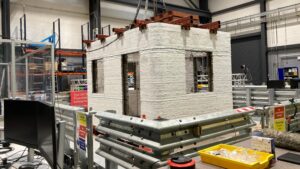
Researchers at the University of Bristol have conducted the UK’s first major earthquake simulation on a 3D-printed concrete building, aiming to understand how this emerging construction technology performs under seismic stress. The experiment used the country’s largest shaking table to mimic the effects of a medium-magnitude earthquake.
3D-printed concrete is gaining global interest for its potential to build strong, affordable, and sustainable structures quickly. However, its earthquake resistance remains largely untested. Unlike traditional concrete which has well-understood seismic properties—3D printing introduces new design features such as layered construction, unique material behavior, and non-standard geometries. These differences may affect how such buildings respond to earthquakes.
Leading the project, Prof Anastasios Sextos and Dr Raffaele De Risi explained that this test is crucial to uncover how 3D-printed structures behave during ground shaking. “We want to identify the strengths, weaknesses, and possible failure points of this new construction method,” they said.
For the experiment, a nearly full-size 3D-printed concrete unit was created using robotic additive manufacturing. It was carefully equipped with sensors to measure vibrations, movement, and potential cracking. The structure was then subjected to a range of simulated earthquake motions, starting with light tremors and increasing to stronger, potentially damaging shakes. Each test provided valuable data on the structure’s performance.
The results will help compare the earthquake resilience of 3D-printed concrete with that of traditional building methods. The findings will also validate computer models used to predict seismic behavior and guide improvements in design—such as how layers are bonded and how reinforcement is added within the print.
According to Dr De Risi, these insights are a first step towards setting safety standards and building codes for 3D-printed structures in earthquake-prone areas. “Our goal is to show whether 3D-printed concrete can meet existing seismic safety requirements and to shape future guidelines that support this new technology,” he said.
The broader impact of this research could be significant. Faster, cheaper, and customizable 3D-printed buildings could be used for homes, emergency shelters, and essential infrastructure designed specifically to withstand earthquakes. This study may also encourage policymakers to include 3D printing methods in construction regulations worldwide.
Dr De Risi concluded: “By testing the earthquake strength of 3D-printed concrete for the first time, we’re not just studying a technology—we’re helping to shape the safer and smarter buildings of tomorrow.”
